You'll find a rich palette of plant-based colors perfect for marbling soap, from deep purples using alkanet root to vibrant greens with spirulina powder. Rose clay creates consistent pink hues, while turmeric and paprika offer warm sunset tones. French green clay provides enduring earthy shades, and indigo powder delivers striking blue contrasts. For best results, combine different natural colorants like matcha and spirulina to achieve varied depths and unique patterns. The world of natural soap coloring holds endless creative possibilities.
Understanding Plant-Based Soap Colorants
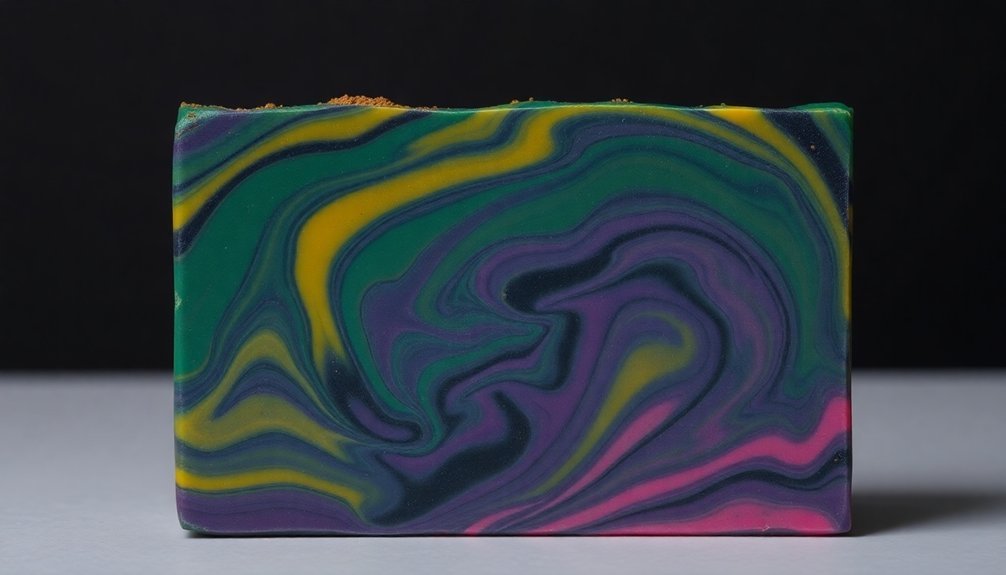
Five remarkable plant-based colorants can transform your homemade soap into a stunning work of art.
You'll find alkanet root creating mesmerizing changes from purple to blue during saponification, while rose clay delivers consistent pink hues perfect for marbling effects.
If you're seeking green tones, spirulina powder offers vibrant results, and French green clay provides enduring earthy shades.
For the best marbling results, mix plant powders like madder root with your oils before adding them to your soap mixture. This technique guarantees even distribution and creates dramatic swirls.
Don't overlook the visual appeal of dried calendula petals, which maintain their color despite high pH levels.
These natural colorants don't just add beauty – they work harmoniously with your soap's chemistry to create lasting, stable hues.
Essential Tools for Natural Marble Soaping
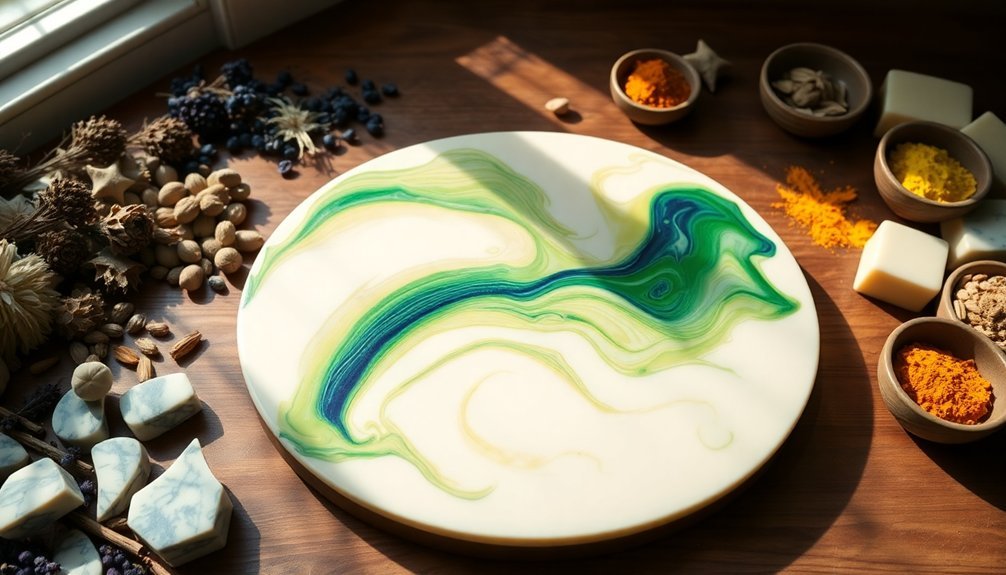
You'll need precise measuring tools, including a digital kitchen scale and graduated containers, to create consistently beautiful marbled soaps using plant-based ingredients.
Store your natural colorants in airtight, labeled containers away from direct light to maintain their vibrancy and prevent moisture contamination.
When you're ready to marble, arrange separate mixing bowls for each plant-based color and keep your swirling tools like spatulas and skewers close at hand for seamless color integration.
Measuring Equipment For Success
Creating marbled soaps with natural ingredients requires precise measurements and the right set of tools. You'll need a digital kitchen scale to weigh your oils and colorants with accuracy, ensuring your soap's marbling pattern turns out just as planned.
A reliable thermometer is essential to monitor temperatures, preventing overheating that could compromise your colors and scents.
Keep measuring spoons and cups handy for portioning smaller amounts of natural colorants, like herb powders, before blending them into your soap mixture.
Don't forget a rubber spatula – it's your best friend for achieving that perfect blend without overdoing it.
When you're working with plant-based ingredients, proper measurements make the difference between stunning marble patterns and muddy results. These tools help you maintain consistency in your natural soap-making process.
Natural Colorant Storage Solutions
While creating stunning marbled soaps starts with quality ingredients, proper storage of your natural colorants guarantees their vibrancy and longevity. You'll want to store your plant-based colorants in airtight containers, keeping them away from direct sunlight and moisture to maintain their potency.
| Storage Type | Benefits | Best For |
|---|---|---|
| Glass Jars | UV protection | Light-sensitive plants |
| Opaque Containers | Moisture barrier | Powder colorants |
| Vacuum Sealed | Maximum freshness | Bulk storage |
Don't forget to label each container with the plant name and preparation date. You'll need to monitor your natural colorants regularly for any signs of clumping or color changes. If you notice these warning signs, it's time to replace them. Remember, proper storage directly impacts how vibrant your marbled designs will turn out in your finished soaps.
Plant-Based Marbling Techniques
Successful plant-based marble soaping requires a carefully curated set of essential tools and materials to achieve those stunning swirls and patterns.
You'll need a variety of natural colorants like alkanet root powder for purple and spirulina for green, along with mixing containers to properly disperse these plant powders in carrier oils.
To create your marbled designs, you'll want to gather specialized pouring pitchers for layering different colors, along with a sturdy mixing spatula to blend your ingredients evenly.
Don't forget to include dried herbs and botanicals in your toolkit – calendula petals and lavender buds add both visual interest and natural fragrance.
Keep rose clay on hand for soft pink tones and activated charcoal for dramatic black swirls.
Finally, you'll need a reliable mold that allows for easy layering techniques.
Preparing Plant Materials for Color Extraction
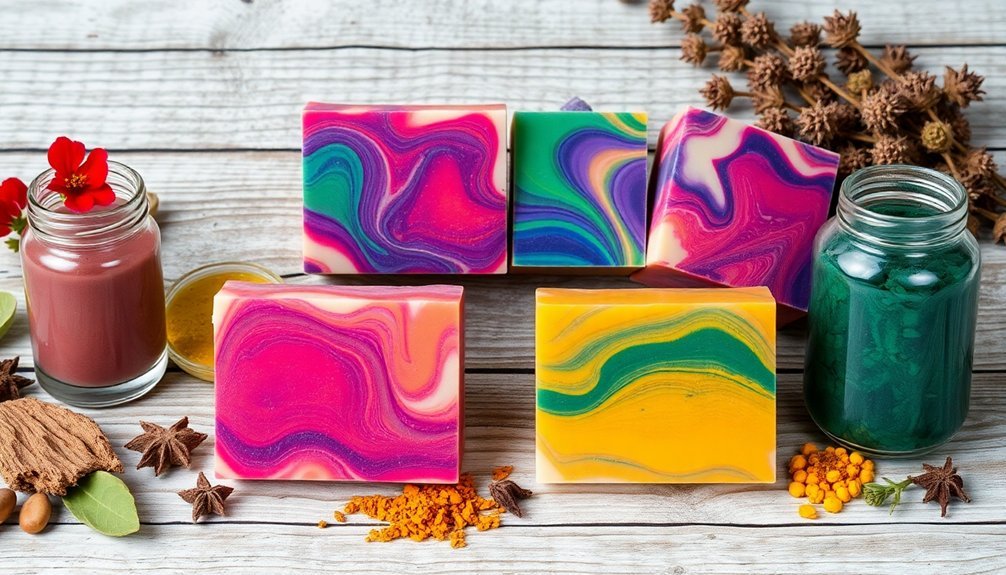
When you're gathering plants for soap marbling, you'll need to dry them completely using either air-drying in a well-ventilated space or a food dehydrator set to low heat.
Your infusion time can range from 2-8 weeks depending on the plant material, though you can speed up the process by using a slow cooker on low heat for 4-6 hours.
Remember to maintain ideal temperatures between 100-120°F during heat infusion to preserve the plants' beneficial properties while extracting their vibrant colors.
Drying Methods For Plants
Before extracting natural colors for soap marbling, proper drying of your plant materials is vital to preserve their vibrant pigments and prevent spoilage.
You'll find several effective drying methods for plants that guarantee ideal color extraction while maintaining their natural properties.
- Air dry your plants by hanging them in a cool, dark space to preserve their colors and essential oils.
- Use your oven at 180°F, spreading materials on a baking sheet and checking regularly.
- Try microwave drying between paper towels in short bursts for quick results.
- Set up a dehydrator for controlled temperature and airflow, perfect for maintaining vibrant colors.
- Confirm your dried plant materials are completely brittle before grinding or infusing them to maximize color extraction.
Choose the method that best suits your timeline and available equipment, remembering that proper drying is vital for successful soap marbling.
Infusion Time And Temperature
To achieve rich, vibrant colors for your soap marbling, proper infusion of dried plant materials demands careful attention to both time and temperature. You'll want to maintain your infused oil between 100°F and 140°F (37-60°C) for ideal pigment extraction without damaging the botanicals.
| Plant Type | Infusion Time | Temperature |
|---|---|---|
| Soft Herbs | 4-8 hours | 100°F (37°C) |
| Flowers | 24-72 hours | 120°F (49°C) |
| Roots/Bark | 1-2 weeks | 140°F (60°C) |
Mix your dried plant materials with oil using a ratio between 1:2 and 1:5, depending on your desired color intensity. Remember to strain your infused oil through cheesecloth or fine mesh before use. While longer infusion times typically yield deeper colors, you'll need to monitor the process to prevent any unwanted degradation of your botanical materials.
Root-Based Natural Dye Options
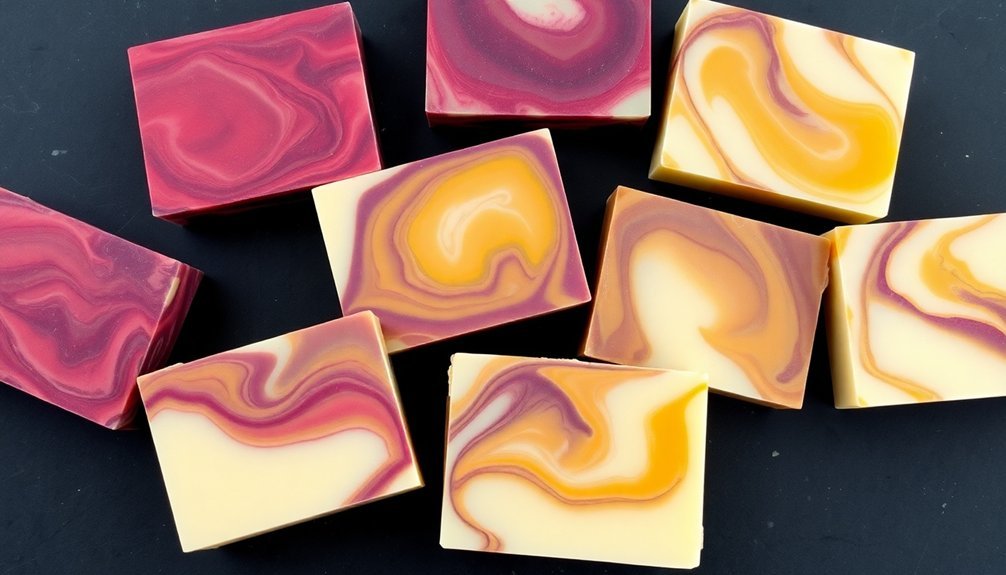
Since nature provides an abundant array of root-based dyes, you'll find several excellent options for marbling your soaps with vibrant, natural colors.
Root-based natural dyes offer both aesthetic appeal and beneficial properties to your soap creations. You'll discover that each root brings its unique characteristics and vibrant hues to your marbling projects.
Natural root dyes enhance soap with vibrant marbling while adding botanical benefits – each root contributes its own special colors and properties.
- Alkanet root creates striking purple shades that transform during saponification.
- Turmeric root delivers sunny yellow tones while adding anti-inflammatory properties.
- Madder root produces rich reds to pinks that vary with your soap's pH level.
- Beetroot powder achieves beautiful pink to deep red hues, though they may fade.
- Carrot root powder infuses orange tints while enriching your soap with beta-carotene.
Choose these natural colorants to create stunning marbled effects while maintaining your commitment to plant-based ingredients.
Flower and Leaf Pigment Sources
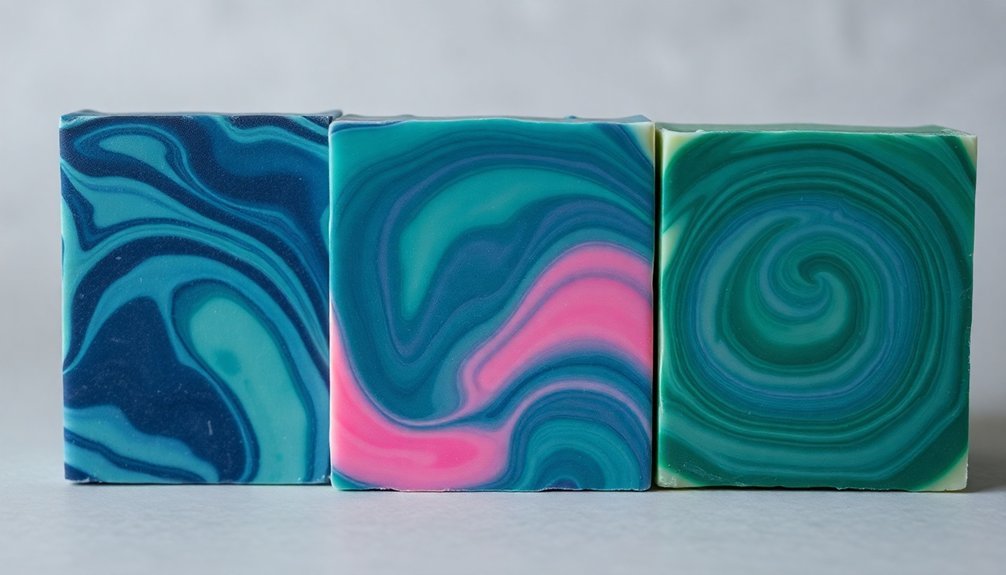
Beyond root-based dyes, flowers and leaves provide an extensive palette of natural pigments for marbling soaps. When you're developing your soap recipe, you'll find that plant colorants from flowers and leaves offer unique marbling possibilities. Spirulina powder stands out as a powerful green pigment source that'll give your marble soap a striking appearance while nourishing the skin.
| Plant Source | Color | Best Use |
|---|---|---|
| Spirulina | Deep Green | Top Layer |
| Chamomile | Soft Yellow | Middle Swirls |
| Calendula | Golden Yellow | Base Tone |
To achieve the best results with flower and leaf pigment sources, infuse them into your soap-making oils before beginning the marbling process. You'll notice that chamomile and calendula create subtle yellow tones that work beautifully as background colors, while spirulina provides bold contrast for dramatic marbling effects.
Spice and Herb Color Combinations
When exploring natural soap colorants, spices and herbs offer an extensive range of earthy tones that you'll find essential for creating sophisticated marbling effects.
You can combine natural colorants to achieve stunning designs while enhancing skin health. Turmeric's anti-inflammatory properties pair beautifully with spirulina's antioxidants, creating a striking yellow-green contrast. Paprika adds both color and exfoliating properties to your soap designs.
- Mix turmeric and alkanet root for a dramatic yellow and purple swirl
- Blend matcha and spirulina for varied green depths
- Combine paprika and turmeric for warm sunset effects
- Layer alkanet root with spirulina for purple-green contrast
- Create ombré effects by gradually incorporating matcha into your base
These combinations not only produce beautiful marbling patterns but also infuse your soaps with beneficial properties that support healthy skin.
Creating Swirl Patterns With Plant Colors
The vibrant world of plant-based soap marbling opens up endless possibilities for creating mesmerizing swirl patterns in your homemade soaps.
You'll find that natural colorants like alkanet root powder can produce stunning purple swirls, while spirulina creates rich green marbling effects. For softer, more romantic designs, try using rose clay to achieve delicate pink patterns.
Want to create dramatic contrasts? Combine indigo powder's striking blue with lighter shades, or experiment with turmeric's bright yellow against cocoa powder's earthy brown.
You can enhance your marbling effects by mixing different plant-based colorants, such as clays with herbal additives. These combinations won't just give you beautiful swirl patterns – they'll also reflect your unique artistic vision while keeping your soap purely natural.
Temperature Effects on Natural Pigments
When you're working with plant-based colorants in soap marbling, you'll find that temperature control is essential for maintaining the stability and vibrancy of natural pigments.
You can preserve the true colors of your botanical extracts by using cold extraction methods and keeping your soap mixture below 120°F during the mixing phase.
To protect your finished marbled soaps from color degradation, you'll want to store them in a cool, dark place between 60-75°F, which helps maintain the integrity of those carefully crafted swirl patterns.
Heat Impacts Color Stability
Since temperature plays a crucial role in natural soap coloring, you'll need to carefully monitor and control heat levels throughout the marbling process.
Heat impacts color stability markedly, as natural pigments can shift dramatically during saponification. When working with plant-based colorants, keep your soaping temperature below 100°F to preserve their vibrancy and prevent uneven color distribution.
- Alkanet root changes color intensity based on both heat and pH levels
- Temperature fluctuations can cause some areas of your marble design to fade faster than others
- The gel phase can enhance color vibrancy when you properly insulate your soap
- Higher temperatures often trigger more pronounced color shifts in plant-based pigments
- Maintaining consistent temperature helps maintain even color distribution throughout your marbled design
Cold Extraction Preserves Pigments
Because natural plant pigments are highly sensitive to heat, cold extraction methods offer the best way to preserve their vibrant colors for soap making.
When you're working with natural colorants like alkanet root or indigo, you'll want to steep them in oils at room temperature to maintain their color integrity.
Cold extraction proves particularly effective for cold process soap because it helps you retain the delicate pigments that might otherwise break down at higher temperatures.
You'll need to be patient, as longer steeping times result in more concentrated and stable colors. This method lets you create unique, rich hues without compromising the plant's natural properties.
Optimal Temperature Storage Range
To maintain the vibrancy of your plant-based soap colorants, you'll need to store them within a specific temperature range of 60°F to 75°F (15°C to 24°C). This ideal temperature storage range guarantees your natural colorants remain stable throughout the soap making process and beyond.
Storing your soaps in a cool, dark place helps preserve their marbled appearance and prevents color degradation.
- Monitor storage conditions regularly to prevent temperature fluctuations
- Keep soaps away from direct sunlight and heat sources
- Store finished soaps in a climate-controlled environment
- Watch temperature during the gel phase to protect color stability
- Choose storage containers that maintain consistent temperatures
Remember that extreme temperatures are your marbled soap's enemy. Whether too hot or too cold, temperature variations can cause your natural colorants to fade or distribute unevenly, compromising your soap's artistic design.
Achieving Color Stability in Plant-Dyed Soaps
While creating beautiful marbled designs with plant-based colorants can be exciting, maintaining their vibrancy presents unique challenges.
You'll need to reflect on how pH levels during saponification affect your chosen colorants and plan for potential fading over time.
To achieve the best color stability, store your soaps in cool, dark places away from direct light. Some natural colorants, like French green clay and rose clay, offer better longevity than others, making them reliable choices for your marbling effects.
When you're working with botanical options like calendula petals or indigo powder, remember that your soap recipe and curing conditions will influence the final outcome.
Before committing to a large batch, it's smart to test your plant-based colorants in small amounts. This way, you'll know exactly how your chosen colors will perform and maintain their vibrancy.
Blending Multiple Plant Colorants
When experimenting with multiple plant colorants, you'll discover endless possibilities for creating unique soap designs. By blending multiple plant colorants with oils before adding them to your soap mixture, you'll achieve consistent marbling effects and vibrant results.
Natural plant colorants offer a world of artistic possibility, transforming simple soap into stunning marbled masterpieces through thoughtful oil-based blending.
It's crucial to test your combinations first, as natural colorants can interact differently during saponification.
- Mix alkanet root powder with Brazilian clay for striking purple-to-green shifts
- Combine spirulina with rose clay to create soft, pastel green swirls
- Layer French green clay with other colorants for enhanced texture and depth
- Blend complementary plant powders to achieve custom color palettes
- Test small batches to understand how your chosen colorants perform together
Remember that clays not only contribute to your color palette but also improve your soap's texture and hardness, making them valuable additions to your marbling toolkit.
Testing and Recording Color Results
Successful plant-based soap marbling depends on systematic color testing and detailed record-keeping.
You'll want to start with a pure white soap base to accurately test and document color outcomes from your plant-based colorants.
Begin by dispersing your chosen plant powders, like olive leaf or alkanet root, in carrier oil using consistent ratios of 4 teaspoons per 4 ounces of soap.
Watch your colors closely during the gel phase, as this is when they'll show their true potential.
Document how each plant colorant behaves throughout the process, noting any changes during saponification.
Make sure you're recording the initial color, how it develops during curing, and its final appearance.
This systematic approach to testing and recording color results will help you create reliable marbling effects in future batches.
Frequently Asked Questions
What Flowers Don't Turn Brown in Soap?
You'll find calendula, alkanet root, lavender, mallow, and hibiscus flowers won't brown in your soap. These natural additives maintain their vibrant colors during saponification, giving you beautiful, stable hues in your finished bars.
What Herbs Are Good for Coloring Soap?
You'll get vibrant colors using alkanet root for purple, spirulina for green, annatto seeds for orange-yellow, chamomile for light yellow, and red clay for reddish-brown. These natural herbs create beautiful, skin-safe soap colors.
What Turns Soap Purple?
You'll get beautiful purple soap using alkanet root powder infused in oil, purple Brazilian clay, or indigo powder mixtures. The most vibrant results come from alkanet, especially in more alkaline conditions.
Which Color Is Best for Soap Making?
You'll find there's no single "best" color for soap making. You can create stunning soaps with natural options like indigo's blue, alkanet's purple, spirulina's green, or turmeric's yellow – choose what suits your design.
In Summary
You'll find endless possibilities for marbling soaps with natural plant dyes, from deep purples with alkanet root to vibrant yellows from turmeric. Remember to document your experiments, as each plant reacts differently to soap's pH and temperature. Keep testing small batches and adjusting your technique – soon you'll master the art of creating beautiful, naturally colored marble soaps using nature's own palette.

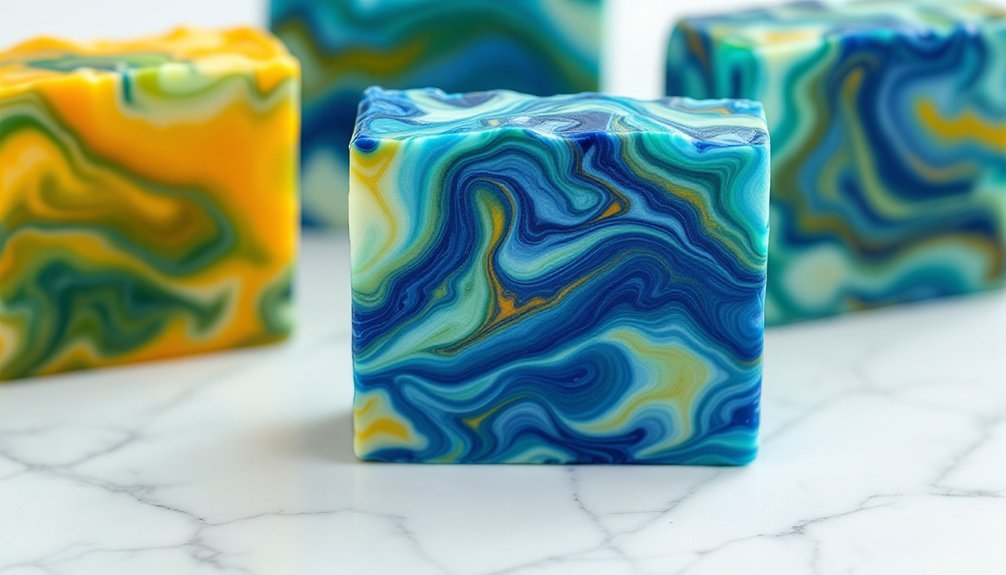



Leave a Reply